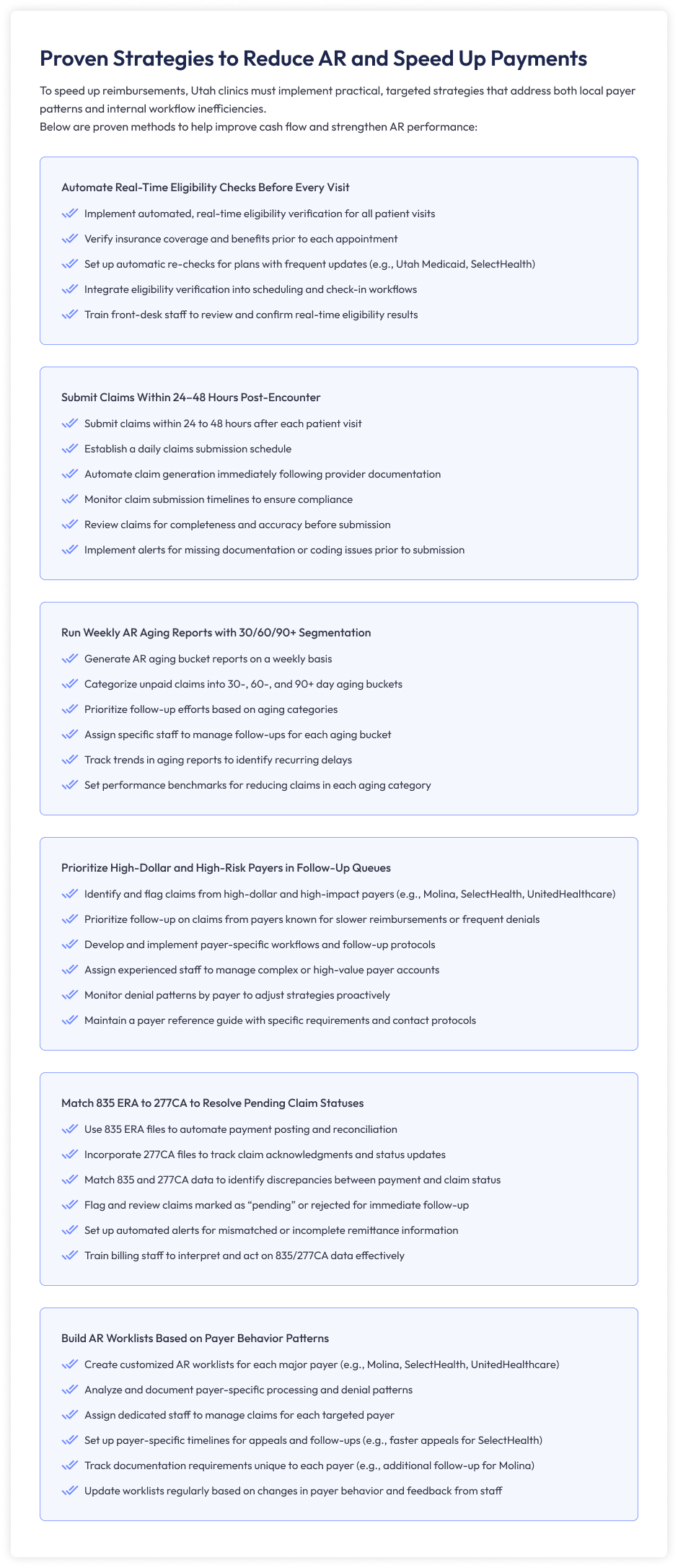Speed Up Reimbursements: Proven AR Best Practices for Utah Clinics
July 18, 2025

In Utah’s healthcare system, each day a payment is delayed adds an extra burden. The money owed to clinics by insurance companies, individuals, and government programs—such as Utah Medicaid and SelectHealth—after the delivery of medical services is referred to as accounts receivable (AR).
However, getting paid is not always straightforward, especially in Utah. Complex paperwork and slow processing often delay reimbursements from Utah Medicaid and insurers such as SelectHealth.
The impact of accumulating AR days goes beyond financial strain. It leads to more denied claims, tighter cash flow, and staff working overtime to keep up. For many providers, it’s not just a billing issue—it’s a major source of stress and burnout, affecting practices across the state.
Clinics across Utah—from full-service specialty centers in Salt Lake City to rural family practices—depend on effective accounts receivable (AR) management. A clinic’s cash flow is directly impacted by the time between delivering services and receiving payment.
Delayed reimbursements disrupt more than your clinic’s bottom line—they can affect payroll, staff training, equipment upgrades, and service expansion plans. Even well-managed practices can suffer under this domino effect.
Utah’s unique payer ecosystem—which includes a mix of national insurers, Utah Medicaid, Molina Healthcare, and SelectHealth—adds complexity to the process. Each payer operates with its own set of rules for approvals, billing procedures, and claim appeals.
For example:



Not all payers respond the same way—especially in Utah, where regional insurers like SelectHealth and Molina Healthcare, along with state Medicaid programs, have unique policies that influence payment timing. To reduce AR days and avoid unnecessary delays, clinics must tailor their billing processes to each payer’s specific requirements.
The following proven tips are based on Utah’s payer behaviors:
| Payer | Best Practices | Submission Channel |
| Utah Medicaid | Monitor real-time denial alerts and accelerate resubmission of corrected claims using the PRISM site. Stay vigilant for mid-fiscal year updates to NCPDP edits and modifier guidelines. | Direct submission via PRISM |
| SelectHealth | When submitting claims, always double-check modifiers—especially 25, 59, and 91. Claims missing these modifiers or with incorrect sequencing are frequently rejected by this payer. Incorporate validation rules into your clearinghouse workflow to catch these issues before submission. | Availity |
| Molina Healthcare | Carefully review batch-level rejections and Third-Party Liability (TPL) flags, as these can delay entire claim submissions. Denials often stem from member coordination of benefits (COB) issues. | Molina Provider Portal |
As there are many factors that can affect AR turnaround times, it is crucial for providers to understand the precise components that affect the speed at which payments are received. AR performance is affected by changes in payer regulations, claim submission processes, specialty-specific restrictions, and patient demographics. Understanding and adjusting to these factors is essential for streamlining processes, minimizing delays, and boosting overall revenue cycle accuracy.
ERA/EFT Setup Varies by Payer
When your ERA is not operational, EOB reconciliation becomes a time-consuming manual process, slowing down denial follow-up and creating gaps in denial management.
Re-Credentialing Delays Can Freeze Payments
Some payers, including Utah Medicaid and SelectHealth, may place claims in a waiting queue or suspend payments when re-credentialing is required. It often leads to increased AR aging, as clinics frequently remain unaware of the issue for weeks.
Tracking key Accounts Receivable (AR) performance metrics is essential for Utah clinics seeking to maximize revenue cycle efficiency and expedite reimbursements. These metrics help pinpoint operational bottlenecks, payer-specific challenges, and potential cash flow delays.
This metric indicates the average number of days it takes your clinic to receive payment for services rendered. Clinics with a Days in AR exceeding 40 may face significant cash flow challenges. Implementing robust front-end procedures and maintaining consistent AR follow-ups can help keep Days in AR below 35.
This metric represents the percentage of your accounts receivable that is aging and may become uncollectible. High percentages often indicate inadequate follow-up, payer denials, or billing delays.
The Clean Claim Rate (CCR) represents the percentage of filed claims that are error-free and require no manual intervention or correction. A high CCR accelerates payments and reduces denials.
This KPI measures the number of claims that payers accept on the first submission without rejection. While it reflects payer-side acceptance, it is closely related to the Clean Claim Rate (CCR).
Monitoring denial rates by payer helps identify which insurers frequently deny claims and the reasons behind those denials. This insight can guide improvements in documentation or targeted staff training, for example, ensuring prior authorizations are properly handled for behavioral health services.
Here’s a sample chart:
|
KPI |
Ideal Bench Mark |
| Days in AR | < 35 days |
| % of AR Over 90 Days | < 15% |
| Clean Claim Rate | > 95% |
| First-Pass Acceptance Rate | > 98% |
| Denial Rate by Payer | < 5% overall |
Speeding up reimbursement requires more than just adding staff; it also means equipping your clinic with the right technology stack. For Utah-based clinics—especially those managing multiple payers like SelectHealth, Molina, Medicare, and commercial insurers—utilizing appropriate billing and Revenue Cycle Management (RCM) technologies can significantly improve AR outcomes.
Below are some of the most effective platforms and technologies for AR optimization, particularly suited for small to midsize practices:
These tools are essential for managing end-to-end revenue cycle workflows—from scheduling and billing to collections.
Kareo: Ideal for small, solo practices, integrates real-time eligibility checks, denial management, and claim tracking.
Athenahealth: Cloud-based platform featuring a payer rules engine and advanced claim scrubbing tools, recognized for leveraging automation to reduce AR days.
AdvancedMD(HQ in South Jordan, Utah): Ideal for clinics with multiple specialties, this solution integrates seamlessly with internal billing teams or external partners and offers customizable AR dashboards.
Clearinghouses ensure your claims are processed quickly and accurately by payers. They provide ERA/EOB integration, denial management, and real-time claim status updates.
Availability: Widely used in the western United States and free for many payers, this platform offers comprehensive eligibility checks and detailed insights into payer-specific denials.
ZirMed (now part of Waystar): Known for its customizable AR dashboards and advanced payer analytics, this platform excels at identifying the root causes of denials.
Waystar: Well-suited for multi-location clinics, this platform offers automated claim status updates, auto-resubmission workflows, and denial prediction capabilities.
Having a clear internal view of AR analytics is just as important as using external platforms.
Look for systems or integrations that support:
Denial Tagging: Denials should be categorized by payer, reason, and appeal viability. This approach helps billing teams save hours each week and improves overall efficiency.
Claim Timers: Use visual countdowns to track when claims are approaching filing deadlines—especially important for Utah Medicaid and commercial insurance plans
Payer Behavior Analytics: Identity which payers frequently deny common CPT codes, underpay, or delay reimbursements to target follow-ups and negotiations better.
If you’re a healthcare provider based in Utah, now is the time to take control of your revenue cycle and get rid of costly AR delays. Our team of local billing specialists understands the unique payer policies in Utah—from navigating SelectHealth denials to optimizing claims for Utah Medicaid.
If you’re struggling with an aging AR backlog or struggling with recurring claim denials, Contact Us today. We’ll help you pinpoint the root causes and implement practical, tech-backed solutions that get you paid faster.
Book your free AR review today.
In Utah, an AR day count exceeding 40 is generally considered high. The industry benchmark for healthy AR is under 35 days, with many top-performing clinics in the state aiming for a range of 28–32 days. When AR consistently exceeds 40 days, it often points to workflow issues such as delayed charge entry, incomplete documentation, or slow follow-up. Certain specialties—like behavioral health or pain management—may naturally trend higher due to complexities with prior authorizations or documentation requirements.
However, consistent performance above 45 days should prompt a thorough review of billing processes. It’s also essential to benchmark AR by the payer. Since timelines vary between Medicare, SelectHealth, and Utah Medicaid, relying on a single blended AR figure can obscure payer-specific problems that require targeted action.
Ideally, your team should begin following up on unpaid claims within 14–21 days of submission, particularly for high-dollar claims or those involving government payers. For commercial payers in Utah, such as Regence BlueCross BlueShield or Cigna, following up every 14–18 days helps ensure claims remain within the timely filing and appeal windows.
The best practice is to categorize AR by aging buckets (e.g., 0–30, 31–60, 61–90 days) and prioritize follow-up based on both claim value and payer behavior. Automating reminders or using claim timers within your RCM system can streamline this process and minimize missed reimbursement opportunities.
In the Utah market, SelectHealth is generally reliable but can experience delays when documentation is incomplete or authorization protocols aren’t properly followed. Utah Medicaid—though improving in electronic data interchange (EDI) processing—remains slower due to strict eligibility documentation requirements and batch processing cycles. PEHP (Public Employees Health Plan) may also cause reimbursement delays, often driven by frequent policy changes and manual review procedures.
Among commercial payers, UnitedHealthcare and Cigna are frequently flagged for delayed payments, typically due to coordination of benefits (COB) issues or claims being held for medical necessity reviews. Tracking denial reasons by payers can help identify trends and highlight which payers require more proactive management in your AR workflows.
Yes—outsourced billing can significantly reduce AR delays, particularly for clinics facing staffing shortages or inefficient internal processes. Many Utah clinics partner with third-party Revenue Cycle Management (RCM) firms to handle tasks such as claim follow-ups, denial management, and financial reporting. It allows in-house teams to focus more on patient care.
Outsourced billing partners often provide access to specialized staff, proven workflows, and advanced technology integrations that smaller practices may lack internally. However, for outsourcing to be truly effective, it must include full transparency, regular performance reporting, and a clear escalation process for denials and payer issues.
The most successful outcomes occur when outsourced billing teams operate as a seamless extension of your clinic, not just a back-office vendor.
Absolutely. While both are essential components of the revenue cycle, Accounts Receivable (AR) management refers to the overall process of tracking and collecting payments on billed claims. In contrast, denial management focuses specifically on handling claims that have been rejected or denied by payers.AR management involves monitoring outstanding balances, establishing follow-up schedules, and escalating aging claims. Denial management, as a more targeted function, dives deeper into identifying rejection reasons, appealing denied claims, and refining internal workflows to prevent recurring issues.
In essence, denial management is a critical subset of AR management. Without a strong, proactive denial strategy, your AR days and aging metrics will inevitably decline.